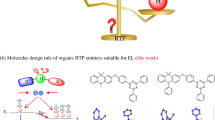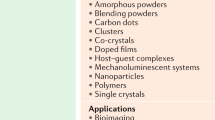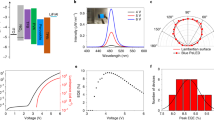Abstract
Stable and efficient organic light-emitting diodes (OLEDs) operating at high brightness are desirable for future high-resolution displays and lighting products. Here, we report a tetradentate Pd(ii) complex called Pd3O8-P, which has attractive optoelectronics properties. At room temperature, aggregates of Pd3O8-P exhibited a close-to-unity photoluminescent quantum yield and a short transient lifetime of 0.62 μs. A host-free Pd3O8-P yellow-orange OLED emitted light with a peak at 588 nm, a half-bandwidth of 84 nm and CIE coordinates of (0.52, 0.47), and achieved a peak external quantum efficiency (EQE) of 34.8%. The device had reduced efficiency roll-off, retaining high EQEs of 33.5% at 1,000 cd m−2 and 29.5% at 10,000 cd m−2. The estimated operational half-lifetime was 9.59 million hours at 1,000 cd m−2. The fact that the tetradentate metal complex has a triplet in the blue-emitting region may also assist the development of efficient and long-lived blue OLEDs in the future.
This is a preview of subscription content, access via your institution
Access options
Access Nature and 54 other Nature Portfolio journals
Get Nature+, our best-value online-access subscription
$29.99 / 30 days
cancel any time
Subscribe to this journal
Receive 12 print issues and online access
$209.00 per year
only $17.42 per issue
Buy this article
- Purchase on Springer Link
- Instant access to full article PDF
Prices may be subject to local taxes which are calculated during checkout




Similar content being viewed by others
Data availability
The data that support the plots within this paper and other findings of this study are available from the corresponding author upon reasonable request.
References
Tang, C. W. & VanSlyke, S. A. Organic electroluminescent diodes. Appl. Phys. Lett. 51, 913–915 (1987).
Baldo, M. A. et al. Highly efficient phosphorescent emission from organic electroluminescent devices. Nature 395, 151–154 (1998).
Fleetham, T. B., Huang, L., Klimes, K., Brooks, J. & Li, J. Tetradentate Pt(ii) complexes with 6-membered chelate rings: a new route for stable and efficient blue organic light emitting diodes. Chem. Mater. 28, 3276–3282 (2016).
Lee, J. et al. Deep blue phosphorescent organic light-emitting diodes with very high brightness and efficiency. Nat. Mater. 15, 92–98 (2016).
Fleetham, T., Li, G. & Li, J. Phosphorescent Pt(ii) and Pd(ii) complexes for efficient, high-color-quality, and stable OLEDs. Adv. Mater. 29, 1601861 (2017).
Tuong, Ly,K. et al. Near-infrared organic light-emitting diodes with very high external quantum efficiency and radiance. Nat. Photon. 11, 63–68 (2017).
Zhang, Q. et al. Efficient blue organic light-emitting diodes employing thermally activated delayed fluorescence. Nat. Photon. 8, 326–332 (2014).
Hua, H., Hu, X. & Gao, C. A high-resolution optical see-through head-mounted display with eyetracking capability. Opt. Express 21, 30993–30998 (2013).
D’Andrade, B. W. & Forrest, S. R. White organic light-emitting devices for solid-state lighting. Adv. Mater. 16, 1585–1595 (2004).
So, F., Kido, J. & Burrows, P. Organic light-emitting devices for solid-state lighting. MRS Bull. 33, 663–669 (2008).
Baldo, M. A., Adachi, C. & Forrest, S. R. Transient analysis of organic electrophosphorescence. II. Transient analysis of triplet–triplet annihilation. Phys. Rev. B 62, 10967–10977 (2000).
Reineke, S., Walzer, K. & Leo, K. Triplet–exciton quenching in organic phosphorescent light-emitting diodes with Ir-based emitters. Phys. Rev. B 75, 125328 (2007).
Murawski, C., Leo, K. & Gather, M. C. Efficiency roll-off in organic light-emitting diodes. Adv. Mater. 25, 6801–6827 (2013).
Lee, J. et al. Hot excited state management for long-lived blue phosphorescent organic light-emitting diodes. Nat. Commun. 8, 15566 (2017).
Coburn, C., Lee, J. & Forrest, S. R. Charge balance and exciton confinement in phosphorescent organic light emitting diodes. Adv. Opt. Mater. 4, 889–895 (2016).
Zhang, Y., Lee, J. & Forrest, S. R. Tenfold increase in the lifetime of blue phosphorescent organic light-emitting diodes. Nat. Commun. 5, 5008 (2014).
Su, S.-J., Gonmori, E., Sasabe, H. & Kido, J. Highly efficient organic blue-and white-light-emitting devices having a carrier- and exciton-confining structure for reduced efficiency roll-off. Adv. Mater. 20, 4189–4194 (2008).
Park, Y.-S. et al. Exciplex-forming co-host for organic light-emitting diodes with ultimate efficiency. Adv. Funct. Mater. 23, 4914–4920 (2013).
Klimes, K., Zhu, Z.-Q. & Li, J. Efficient blue phosphorescent OLEDs with improved stability and color purity through judicious triplet exciton management. Adv. Funct. Mater. 29, 1903068 (2019).
Lee, S., Kim, K.-H., Limbach, D., Park, Y.-S. & Kim, J.-J. Low roll-off and high efficiency orange organic light emitting diodes with controlled co-doping of green and red phosphorescent dopants in an exciplex forming co-host. Adv. Funct. Mater. 23, 4105–4110 (2013).
Gong, S. et al. Bipolar tetraarylsilanes as universal hosts for blue, green, orange, and white electrophosphorescence with high efficiency and low efficiency roll-off. Adv. Funct. Mater. 21, 1168–1178 (2011).
Kawamura, Y., Brooks, J., Brown, J. J., Sasabe, H. & Adachi, C. Intermolecular interaction and a concentration-quenching mechanism of phosphorescent Ir(iii) complexes in a solid film. Phys. Rev. Lett. 96, 017404 (2006).
Holmes, R. J. et al. Reduced geminate recombination in iridium-based electrophosphorescent materials. Org. Electron. 7, 163–172 (2006).
Kim, K.-H. et al. Crystal organic light-emitting diodes with perfectly oriented non-doped Pt-based emitting layer. Adv. Mater. 28, 2526–2532 (2016).
Li, G., Fleetham, T. & Li, J. Efficient and stable white organic light-emitting diodes employing a single emitter. Adv. Mater. 26, 2931–2936 (2014).
Fleetham, T., Huang, L. & Li, J. Tetradentate platinum complexes for efficient and stable excimer-based white OLEDs. Adv. Funct. Mater. 24, 6066–6073 (2014).
Fleetham, T., Ecton, J., Wang, Z., Bakken, N. & Li, J. Single-doped white organic light-emitting device with an external quantum efficiency over 20%. Adv. Mater. 25, 2573–2576 (2013).
Ganesan, P. et al. Functional pyrimidinyl pyrazolate Pt(ii) complexes: role of nitrogen atom in tuning the solid-state stacking and photophysics. Adv. Funct. Mater. 29, 1900923 (2019).
Wang, Q. et al. A non-doped phosphorescent organic light-emitting device with above 31% external quantum efficiency. Adv. Mater. 26, 8107–8113 (2014).
Fleetham, T., Ji, Y., Huang, L., Fleetham, T. S. & Li, J. Efficient and stable single-doped white OLEDs using a palladium-based phosphorescent excimer. Chem. Sci. 8, 7983–7990 (2017).
Chow, P. K. et al. Strongly phosphorescent palladium(ii) complexes of tetradentate ligands with mixed oxygen, carbon and nitrogen donor atoms: photophysics, photochemistry and applications. Angew. Chem. Int. Ed. 52, 11775–11779 (2013).
Yersin, H., Rausch, A. F., Czerwieniec, R., Hofbeck, T. & Fischer, T. The triplet state of organo-transition metal compounds. Triplet harvesting and singlet harvesting for efficient OLEDs. Coord. Chem. Rev. 255, 2622–2652 (2011).
Li, G., Wolfe, A., Brooks, J., Zhu, Z.-Q. & Li, J. Modifying emission spectral bandwidth of phosphorescent platinum(ii) complexes through synthetic control. Inorg. Chem. 56, 8244–8256 (2017).
Lamansky, S. et al. Synthesis and characterization of phosphorescent cyclometalated iridium complexes. Inorg. Chem. 40, 1704–1711 (2001).
Díez, Á. et al. Structural and luminescence studies on π···π and Pt···Pt interactions in mixed chloro-isocyanide cyclometalated platinum(ii) complexes. Inorg. Chem. 49, 3239–3251 (2010).
Ma, B., Djurovich, P. I. & Thompson, M. E. Excimer and electron transfer quenching studies of a cyclometalated platinum complex. Coord. Chem. Rev. 249, 1501–1510 (2005).
Chan, K. H.-Y., Chow, H.-S., Wong, K. M.-C., Yeung, M. C.-L. & Yam, V. W.-W. Towards thermochromic and thermoresponsive near-infrared (NIR) luminescent molecular materials through the modulation of inter- and/or intramolecular Pt⋯Pt and π–π interactions. Chem. Sci. 1, 477–482 (2010).
Lai, S.-W. et al. Luminescent mononuclear and binuclear cyclometalated palladium(ii) complexes of 6-phenyl-2,2′-bipyridines: spectroscopic and structural comparisons with platinum(ii) analogues. Inorg. Chem. 39, 255–262 (2000).
Lu, W. et al. Structural and spectroscopic studies on Pt···Pt and π–π interactions in luminescent multinuclear cyclometalated platinum(ii) homologues tethered by oligophosphine auxiliaries. J. Am. Chem. Soc. 126, 7639–7651 (2004).
Ma, B. et al. Synthetic control of Pt···Pt separation and photophysics of binuclear platinum complexes. J. Am. Chem. Soc. 127, 28–29 (2005).
Kim, D. & Brédas, J.-L. Triplet excimer formation in platinum-based phosphors: a theoretical study of the roles of Pt–Pt bimetallic interactions and interligand π–π interactions. J. Am. Chem. Soc. 131, 11371–11380 (2009).
Kim, K.-H. & Kim, J.-J. Origin and control of orientation of phosphorescent and TADF dyes for high-efficiency OLEDs. Adv. Mater. 30, 1705600 (2018).
D’Andrade, B. & Forrest, S. R. Formation of triplet excimers and dimers in amorphous organic thin films and light emitting devices. Chem. Phys. 286, 321–335 (2003).
Zhu, Z.-Q., Park, C.-D., Klimes, K. & Li, J. Highly efficient blue OLEDs based on metal-assisted delayed fluorescence Pd(ii) complexes. Adv. Opt. Mater. 7, 1801518 (2019).
Lee, J. et al. Down-conversion white organic light-emitting diodes using microcavity structure. Adv. Energy Mater. 1, 174–178 (2011).
Sun, Y. & Forrest, S. R. Enhanced light out-coupling of organic light-emitting devices using embedded low-index grids. Nat. Photon. 2, 483–487 (2008).
Do, Y. R. et al. Enhanced light extraction from organic light-emitting diodes with 2D SiO2/SiNx photonic crystals. Adv. Mater. 15, 1214–1218 (2003).
Youn, W., Lee, J., Xu, M., Singh, R. & So, F. Corrugated sapphire substrates for organic light-emitting diode light extraction. ACS Appl. Mater. Interfaces 7, 8974–8978 (2015).
Qu, Y., Slootsky, M. & Forrest, S. R. Enhanced light extraction from organic light-emitting devices using a sub-anode grid. Nat. Photon. 9, 758–763 (2015).
Zhu, Z.-Q., Klimes, K., Holloway, S. & Li, J. Efficient cyclometalated platinum(ii) complex with superior operational stability. Adv. Mater. 29, 1605002 (2017).
Zhu, Z.-Q., Fleetham, T., Turner, E. & Li, J. Harvesting all electrogenerated excitons through metal assisted delayed fluorescent materials. Adv. Mater. 27, 2533–2537 (2015).
Féry, C., Racine, B., Vaufrey, D., Doyeux, H. & Cinà, S. Physical mechanism responsible for the stretched exponential decay behavior of aging organic light-emitting diodes. Appl. Phys. Lett. 87, 213502 (2005).
Nakanotani, H., Masui, K., Nishide, J., Shibata, T. & Adachi, C. Promising operational stability of high-efficiency organic light-emitting diodes based on thermally activated delayed fluorescence. Sci. Rep. 3, 2127 (2013).
Seo, S. et al. Exciplex–triplet energy transfer: a new method to achieve extremely efficient organic light-emitting diode with external quantum efficiency over 30% and drive voltage below 3 V. Jpn J. Appl. Phys. 53, 042102 (2014).
Qian, L., Zheng, Y., Xue, J. & Holloway, P. H. Stable and efficient quantum-dot light-emitting diodes based on solution-processed multilayer structures. Nat. Photon. 5, 543–548 (2011).
Li, L.-K. et al. Strategies towards rational design of gold(iii) complexes for high-performance organic light-emitting devices. Nat. Photon. 13, 185–191 (2019).
Forrest, S. R., Bradley, D. D. C. & Thompson, M. E. Measuring the efficiency of organic light-emitting devices. Adv. Mater. 15, 1043–1048 (2003).
Acknowledgements
We thank the Department of Energy (contracts EE0007090 and EE0008721) and Universal Display Corporation for partial support of this work.
Author information
Authors and Affiliations
Contributions
J.L. designed and supervised this research. L.C. and Y.J. conducted the synthesis and characterization of the Pd(ii) complex. K.K., L.C. and T.F. carried out device fabrication and measurements. L.C., T.F. and J.L. contributed to the manuscript.
Corresponding author
Ethics declarations
Competing interests
The authors declare no competing interests.
Additional information
Publisher’s note Springer Nature remains neutral with regard to jurisdictional claims in published maps and institutional affiliations.
Supplementary information
Supplementary Information
Supplementary materials and regents, synthesis of ligand 3O8-P and Figs. 1–8.
Rights and permissions
About this article
Cite this article
Cao, L., Klimes, K., Ji, Y. et al. Efficient and stable organic light-emitting devices employing phosphorescent molecular aggregates. Nat. Photonics 15, 230–237 (2021). https://doi.org/10.1038/s41566-020-00734-2
Received:
Accepted:
Published:
Issue Date:
DOI: https://doi.org/10.1038/s41566-020-00734-2
This article is cited by
-
Modified t-butyl in tetradentate platinum (II) complexes enables exceptional lifetime for blue-phosphorescent organic light-emitting diodes
Nature Communications (2024)
-
Efficient blue electroluminescence from reduced-dimensional perovskites
Nature Photonics (2024)
-
Efficient and stable one-micrometre-thick organic light-emitting diodes
Nature Photonics (2022)
-
A flexible, multifunctional, optoelectronic anticounterfeiting device from high-performance organic light-emitting paper
Light: Science & Applications (2022)
-
Exceptionally stable blue phosphorescent organic light-emitting diodes
Nature Photonics (2022)



